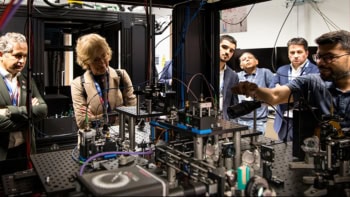Large-scale interferometers built to detect gravitational waves from astrophysical sources may also be able to test various theories of quantum gravity. Developing a quantum theory of gravity is one of the biggest challenges in physics today. Previously it was thought that the effects of quantum gravity were too small to be detected with modern technology. Now, Giovanni Amelino-Camelia of the Université de Neuchâtel in Switzerland has suggested that quantum space-time effects could provide a measurable source of noise in the gravity-wave interferometers being built in the US and Europe. Measurements would therefore we able to rule out certain theories of quantum gravity (Nature 398 216).
Both the French-Italian gravity-wave interferometer, called VIRGO, and the LIGO interferometers in the US are designed to detect very weak gravity waves by using lasers to monitor test masses placed at the ends of the arms of the interferometer. The arms in VIRGO are 3 km long, while those in LIGO are 4 km long. When a gravity wave passes through the detector, it causes the distance between the test masses to increase in one arm of the interferometer, and decrease in the other. The challenge is to detect this movement – which is only about 10-18 m, or one-hundred-millionth the diameter of a hydrogen atom – from the changes it causes in the interference patterns observed in the experiments.
According to Amelino-Camelia, the same type of distortion will be caused by fluctuations in space-time near the Planck length, 10-35 m, and he argues that these fluctuations should be observable as instrument noise on the 10-18 m scale. “We are finally at a point in quantum gravity research when we can set bounds on some candidate phenomena, ” he told PhysicsWeb. “One first rules out the most speculative proposals and then – as the phenomenological programme gets stronger – even the most conservative proposals can be significantly tested.”



